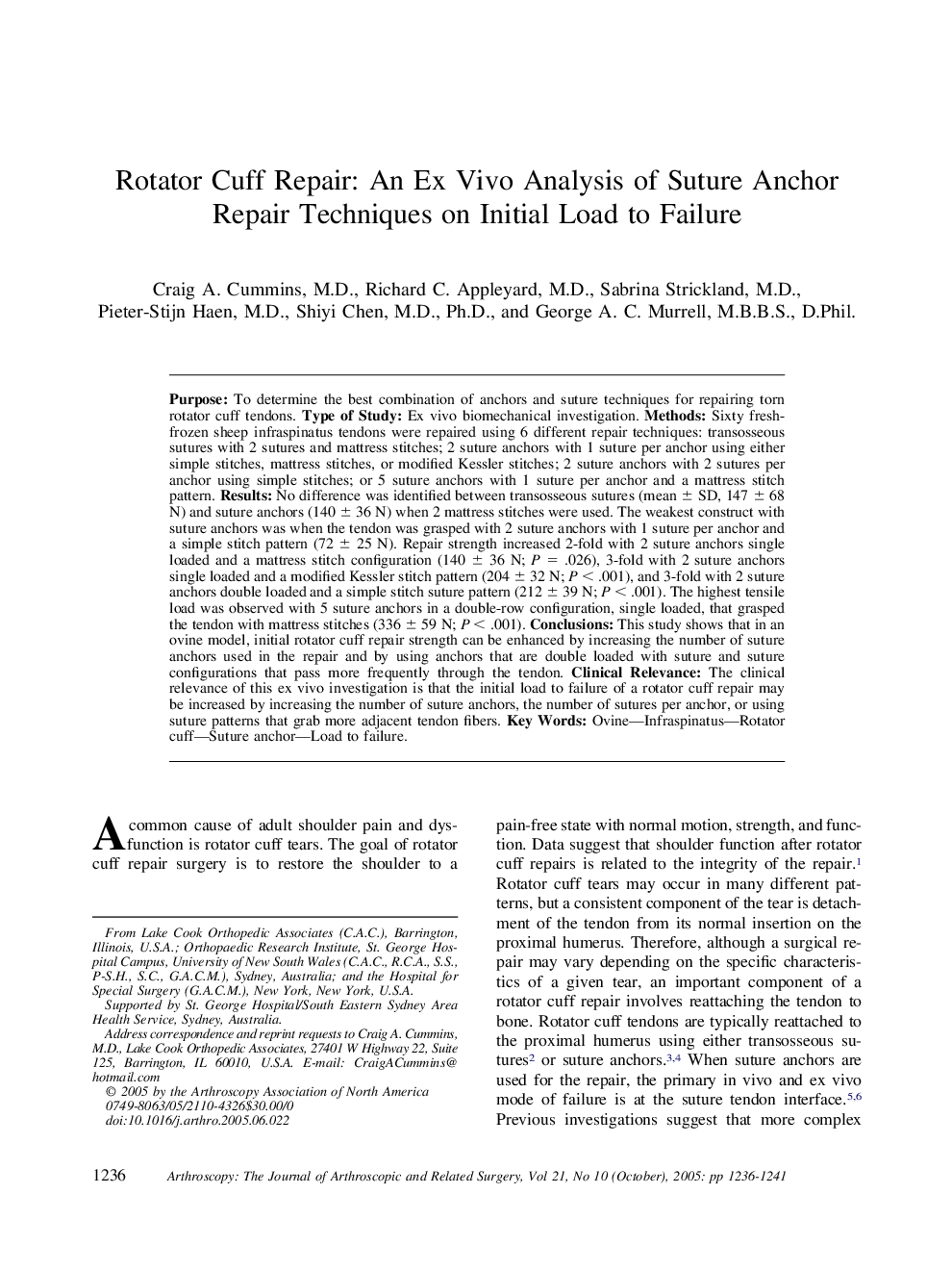| کد مقاله | کد نشریه | سال انتشار | مقاله انگلیسی | نسخه تمام متن |
|---|---|---|---|---|
| 10078820 | 1603618 | 2005 | 6 صفحه PDF | دانلود رایگان |
عنوان انگلیسی مقاله ISI
Rotator Cuff Repair: An Ex Vivo Analysis of Suture Anchor Repair Techniques on Initial Load to Failure
دانلود مقاله + سفارش ترجمه
دانلود مقاله ISI انگلیسی
رایگان برای ایرانیان
کلمات کلیدی
موضوعات مرتبط
علوم پزشکی و سلامت
پزشکی و دندانپزشکی
ارتوپدی، پزشکی ورزشی و توانبخشی
پیش نمایش صفحه اول مقاله

چکیده انگلیسی
Purpose: To determine the best combination of anchors and suture techniques for repairing torn rotator cuff tendons. Type of Study: Ex vivo biomechanical investigation. Methods: Sixty fresh-frozen sheep infraspinatus tendons were repaired using 6 different repair techniques: transosseous sutures with 2 sutures and mattress stitches; 2 suture anchors with 1 suture per anchor using either simple stitches, mattress stitches, or modified Kessler stitches; 2 suture anchors with 2 sutures per anchor using simple stitches; or 5 suture anchors with 1 suture per anchor and a mattress stitch pattern. Results: No difference was identified between transosseous sutures (mean ± SD, 147 ± 68 N) and suture anchors (140 ± 36 N) when 2 mattress stitches were used. The weakest construct with suture anchors was when the tendon was grasped with 2 suture anchors with 1 suture per anchor and a simple stitch pattern (72 ± 25 N). Repair strength increased 2-fold with 2 suture anchors single loaded and a mattress stitch configuration (140 ± 36 N; P = .026), 3-fold with 2 suture anchors single loaded and a modified Kessler stitch pattern (204 ± 32 N; P < .001), and 3-fold with 2 suture anchors double loaded and a simple stitch suture pattern (212 ± 39 N; P < .001). The highest tensile load was observed with 5 suture anchors in a double-row configuration, single loaded, that grasped the tendon with mattress stitches (336 ± 59 N; P < .001). Conclusions: This study shows that in an ovine model, initial rotator cuff repair strength can be enhanced by increasing the number of suture anchors used in the repair and by using anchors that are double loaded with suture and suture configurations that pass more frequently through the tendon. Clinical Relevance: The clinical relevance of this ex vivo investigation is that the initial load to failure of a rotator cuff repair may be increased by increasing the number of suture anchors, the number of sutures per anchor, or using suture patterns that grab more adjacent tendon fibers.
ناشر
Database: Elsevier - ScienceDirect (ساینس دایرکت)
Journal: Arthroscopy: The Journal of Arthroscopic & Related Surgery - Volume 21, Issue 10, October 2005, Pages 1236-1241
Journal: Arthroscopy: The Journal of Arthroscopic & Related Surgery - Volume 21, Issue 10, October 2005, Pages 1236-1241
نویسندگان
Craig A. M.D., Richard C. M.D., Sabrina M.D., Pieter-Stijn M.D., Shiyi M.D., Ph.D., George A.C. M.B.B.S., D.Phil.,